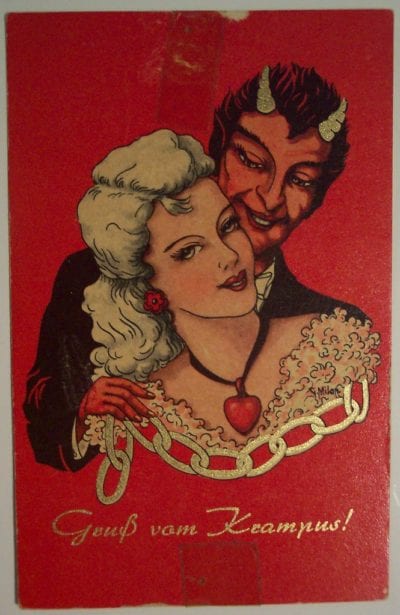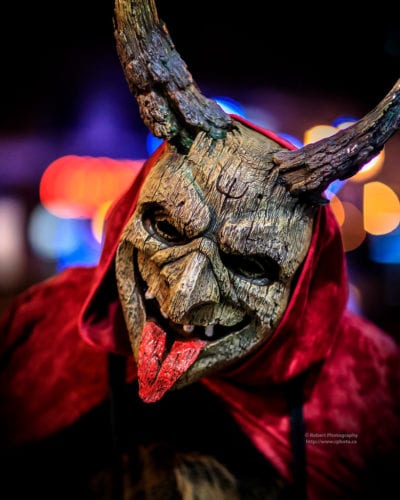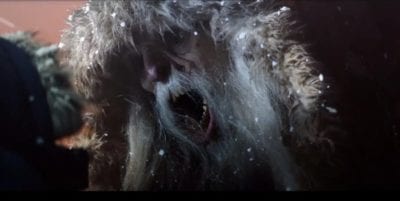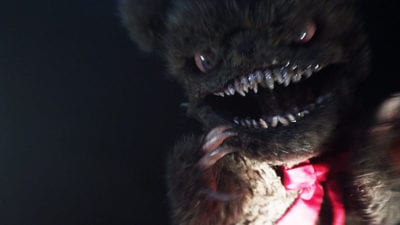Has commercialized holiday cheer got you down? Do you find yourself longing for the ghoulishness of the spooky season amid December decorations? You’ve come to the right place. In the darkest time of the year and in the spirit of traditional ghostly Christmas celebrations, enjoy our “12 Slays of Christmas” series. For twelve days leading up to Christmas day, we will thrill and chill you with analysis of Christmas-related horror films, lore, true crime, and more.
Christmas lore has a new addition and he’s the opposite of kindly and grandfatherly Santa Claus. He’s a large, furry horned creature with hooves named Krampus. He’s Santa’s helper, but his sack doesn’t contain gifts. Krampus’s purpose is to punish those on Santa’s naughty list. Instead of presents, he carries sticks to beat the ill-behaved. His sack is for carrying misbehaving children into the underworld where they’re tortured and eaten.

The feature film, Krampus (2015), among countless other independent films, tells the story of Krampus, but it wasn’t a contemporary writer who created him. Krampus is part of the Christmas tradition in parts of Austria and Germany. Krampus is a recent addition to American Christmas lore.
The legend of Krampus dates back to before Christianity. The name Krampus comes from the German “kramp,” which means “claw.” In Norse mythology, Krampus is the son of Hel, God of the underworld. Krampus chased away winter ghosts during the winter solstice.
With the spread of Christianity, Christians incorporated Krampus into Christmas lore. Santa Claus came on December 5th to reward well-behaved children with candy in their shoes. Naughty children received birch twigs. Krampus would follow Santa to punish ill-behaved children by beating them with sticks or by carrying them off in his sack to the underworld. Some parents even dressed up as Krampus to frighten their children.
During the 1890s, Krampus cards became popular. Gruss Vom Krampus (“Greetings from Krampus”) had artwork featuring Krampus frightening children with his sticks or stuffing them in his sack to take them away. In the early 20th century, more adult Krampus cards began to surface with Krampus proposing to women or being beaten up by them. Others depict Krampus as a woman beating men with her sticks.

The Catholic Church tried to ban Krampus celebrations during the 12th century because Krampus looked like Satan. During the 1930s, Austria’s Christian Social Party also unsuccessfully tried to ban Krampus.
Krampus completes Christmas lore, providing the actual punishment for bad behavior. Instead of just facing a lump of coal in lieu of presents and treats, children faced beatings and damnation for bad behavior. Parents definitely saw Krampus as more of a deterrent to bad behavior.
Many European Christmas traditions have a dark counterpart to Santa Claus. Belsnickel, a fur-clad, masked gift-giver is also popular in parts of Germany and the Pennsylvania Dutch and Brazilian-German communities. He’s described as being both frightening and benign. Belsnickel arrives alone—not with Santa Claus. Knecht Ruprecht also originated in German Christmas lore as one of a group of companions of St. Nicholas who punish ill-behaved children.
Krampuslauf (Krampus Run) is a tradition that continues today in Austria. Also called Perchtenlauf or Klaubaufe, the event is a parade that dates back to the pre-Christian tradition of chasing away winter ghosts. Young men dress up as Krampus and march through the streets. The Krampus run has also gained recent popularity in Germany, Slovenia, Hungary, and the Czech Republic. The event has gained some recognition in the United States with some cities having Krampusnacht festivals.

Natalie Kononenko is a professor and Kule Chair in Ukrainian Ethnography Arts at the University of Alberta in Canada. On the subject of Krampusnacht, she said, “It is weird, but it’s fun. It’s sort of like Halloween. You get to dress up in these really disgusting costumes. You get to do stuff you don’t normally get to do.”
Halloween fascinates us because of its dark, mysterious and mystical themes. Halloween’s popularity has grown over the years. Adding a spooky aspect to Christmas may actually make the holiday more fun for some.
In Michael Dougherty’s film Krampus, the infamous anti-Santa arrives to drag those who’ve lost their Christmas spirit to the underworld. Dougherty said that he first came across the Krampus character when a relative sent him a Krampus card. He said that he became interested in finding out more about Krampus. Dougherty said that he had always been obsessed with Halloween and that he began the same process with writing Krampus as he did with his film Trick ‘r Treat (2007).
Dougherty found that, like Halloween, Christmas’s origins were in pagan tradition. He had always wanted to make a Christmas-themed horror movie. It was his love of Halloween’s spookiness, magic, and mystery that fascinated him, and he was happy to find that Christmas had a dark and mystical side to it. He found his perfect Christmas horror tale and decided to put Krampus back in Christmas.

Dougherty said: “It just baffled me. It just didn’t make any sense. Why would we abandon these fun traditions? Because November 1 is a really depressing day for me. It’s like Halloween is over and in come the Christmas songs. I love Christmas. I really do. But something always felt like it was missing. And, lo and behold, you research it and find out, well, Christmas used to be a little bit more like Halloween. And in Europe where they still embrace Krampus, it still is.”
Americans didn’t know much about Krampus until recently. Art director and graphic designer Monte Beauchamp published a book of Krampus cards in 2004 and organized an art show based on the theme. Since then, Krampus cards have turned up on Etsy along with Krampus sweaters.
Besides Michael Dougherty’s 2015 film, there are many other independent Krampus-themed Christmas horror movies that popped up. There’s even a comic book series. Krampusnacht festivals are held in American cities such as Orlando, Florida, and Milwaukee, Wisconsin. I think it’s safe to say that Krampus is officially a Christmas icon. Krampus is becoming just as commercialized as Santa Claus.
Why now are we embracing a darker side to Christmas? Is it a sign of the times? Are many people simply tired of old traditions? Krampus offers a darker side of Christmas that many of us who are spooky by nature appreciate. I’ve always loved Halloween more than Christmas and have a year-round love of horror movies and dark lore. It’s not that I don’t like Christmas at all. I agree with Dougherty that I felt like there was something missing.
Krampus’s growing popularity could be because of many vampire ghoul-and-goblin-loving folks like myself. It also may be a sign of the times. I can’t speak for everyone but being a child of the ’80s and a teen of the ’90s, horror movies and TV were very popular.

Elements of horror even seeped into comedy with the ’80s hit Ghostbusters (1984). Disneyesque animated musicals took a ghoulish turn in the ’90s with Tim Burton’s The Nightmare Before Christmas (1993). Elements of horror became common in literature for children and teens with Goosebumps, Harry Potter, and Twilight.
Pop culture has increasingly embraced the darker side of everything from the reimagining of classic horror tales to superheroes. Classic horror characters such as Count Dracula and Frankenstein’s monster got to tell their sides of the story in the ’90s remakes of their stories. Batman and Superman progressed from two-dimensional “good guy” characters with an unwavering devotion to law and order to more three-dimensional characters conflicted about what their roles are in society.
Writers have also dug deeper into the minds of slashers—most notably Rob Zombie‘s reimagined Michael Myers in his 2007 remake of the slasher classic Halloween. Instead of a masked phantom-like man who robotically kills, Myers is portrayed as a mentally disturbed child in a toxic dysfunctional family who grew up with a rage to kill.
I think this is a reflection of society’s loss of childlike simplicity. There came an inevitable questioning of traditional beliefs in all areas of society that exploded during the ’60s.
As always, societal attitudes and emotions are reflected in the creations of its members—art, literature, music, and now movies. As we question more and dive deeper into ourselves, we begin to question more about the world around us. Since the dawn of the age of film and television, we’ve learned more about ourselves as well as what may make other people tick. The deeper we go, the more complex we become. We’ve met our dark sides and need to embrace and express them.
Christmas is evolving in the direction of many other societal conventions—multi-layered with dark as well as light. Deck the halls and make sure all is merry and bright, or Krampus may drag you to the underworld on Christmas night.




One Comment
Leave a Reply